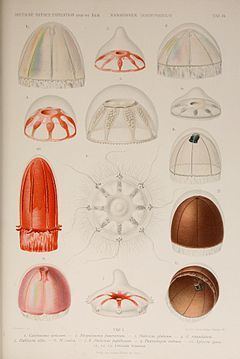Scientific name Trachymedusae Rank Order | ||
 | ||
Order Trachymedusae; Haeckel, 1866 (1879) Similar Narcomedusae, Trachylinae, Limnomedusae, Rhopalonematidae, Leptomedusae | ||
What does trachymedusae mean
Trachymedusae belong to the phylum Cnidaria and the class Hydrozoa, among the 30 genera are 5 families containing around 50 species in all, the family Rhopalonematidae has the greatest diversity.
Contents
Description
Trachymedusae are identifiable by their umbrella edge which lacks any lobes. The edge of the umbrellas have either both solid as well as hollow tentacles or they only have solid tentacles, there is a thickened tissue ring that has a large number of nematocyst, the radial canals number from 4 to 6 to 8 and more than 8, though 8 is the most common amount found. The sensory clubs can be open or closed with the endodermal axis. The gonads are generally located at the radial canal or where the radial canal and the manubrium connect. The cnidome may have stenoteles. Trachymedusae reproduce sexually during the medusae stage lacking a polyp stage.
Distribution
Primarily found in the deep oceans throughout the worlds oceans. Species from this order have been found within the recorded depth ranges of 70–1967m.
Interactions with humans
Being that this species is primarily found in the open and deep oceans the number of interactions with humans are few. Though it is found that hydrozoa's are becoming greater in numbers in recent years, one species of Trachymedusae do not appear to be affecting the zoo-plankton populations they prey upon within the Sea of Marmara.
